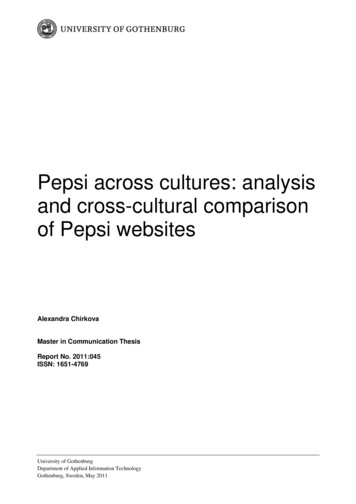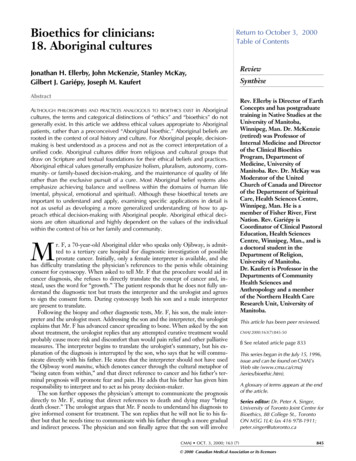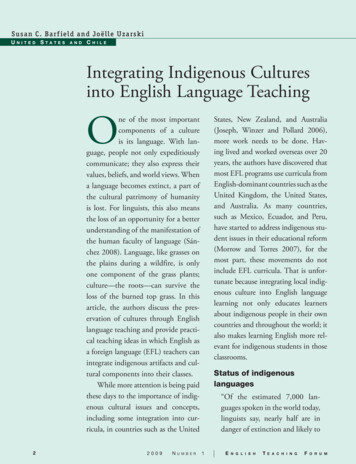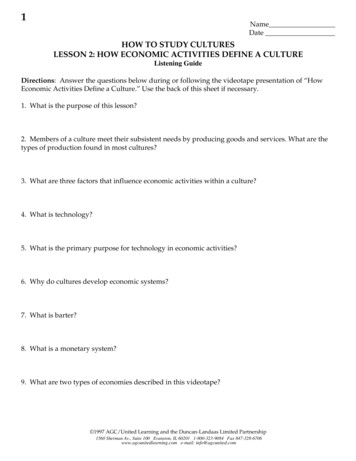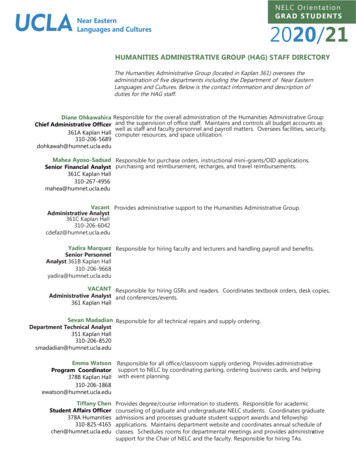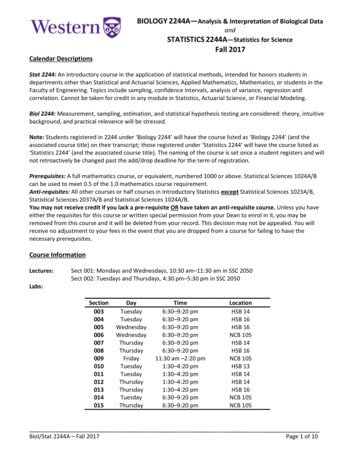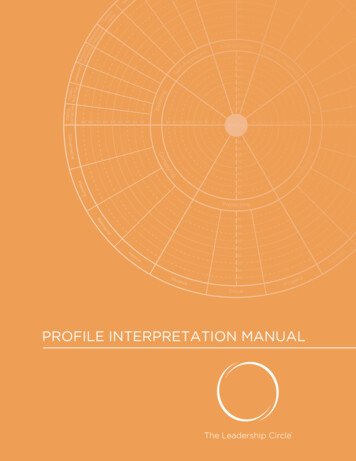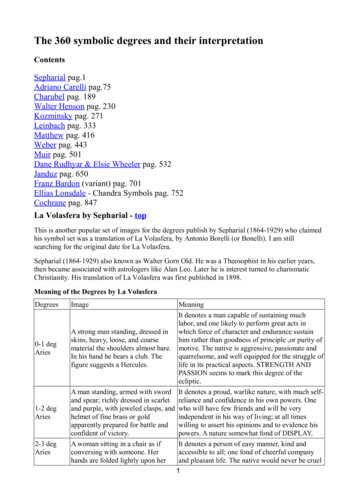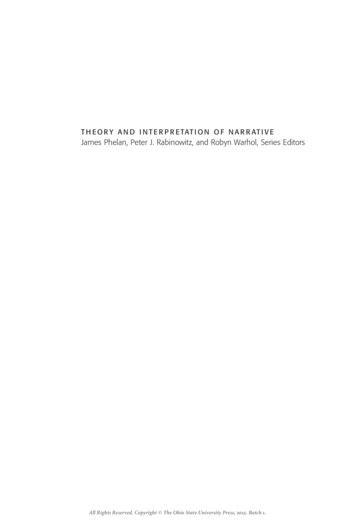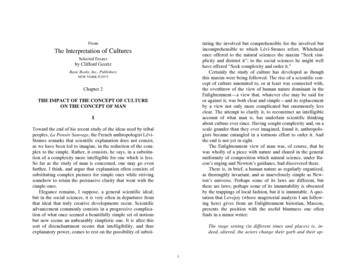
Transcription
Fromtuting the involved but comprehensible for the involved butincomprehensible to which Lévi-Strauss refers. Whiteheadonce offered to the natural sciences the maxim “Seek simplicity and distrust it”; to the social sciences he might wellhave offered “Seek complexity and order it.”Certainly the study of culture has developed as thoughthis maxim were being followed. The rise of a scientific concept of culture amounted to, or at least was connected with,the overthrow of the view of human nature dominant in theEnlightenment—a view that, whatever else may be said foror against it, was both clear and simple—and its replacementby a view not only more complicated but enormously lessclear. The attempt to clarify it, to reconstruct an intelligibleaccount of what man is, has underlain scientific thinkingabout culture ever since. Having sought complexity and, on ascale grander than they ever imagined, found it, anthropologists became entangled in a tortuous effort to order it. Andthe end is not yet in sight.The Enlightenment view of man was, of course, that hewas wholly of a piece with nature and shared in the generaluniformity of composition which natural science, under Bacon’s urging and Newton’s guidance, had discovered there.There is, in brief, a human nature as regularly organized,as thoroughly invariant, and as marvelously simple as Newton’s universe. Perhaps some of its laws are different, butthere are laws; perhaps some of its immutability is obscuredby the trappings of local fashion, but it is immutable. A quotation that Lovejoy (whose magisterial analysis I am following here) gives from an Enlightenment historian, Mascou,presents the position with the useful bluntness one oftenfinds in a minor writer:The Interpretation of CulturesSelected Essaysby Clifford GeertzBasic Books, Inc., PublishersNEW YORK 1973Chapter 2THE IMPACT OF THE CONCEPT OF CULTUREON THE CONCEPT OF MANIToward the end of his recent study of the ideas used by tribalpeoples, La Pensée Sauvage, the French anthropologist LéviStrauss remarks that scientific explanation does not consist,as we have been led to imagine, in the reduction of the complex to the simple. Rather, it consists, he says, in a substitution of a complexity more intelligible for one which is less.So far as the study of man is concerned, one may go evenfurther, I think, and argue that explanation often consists ofsubstituting complex pictures for simple ones while strivingsomehow to retain the persuasive clarity that went with thesimple ones.Elegance remains, I suppose, a general scientific ideal;but in the social sciences, it is very often in departures fromthat ideal that truly creative developments occur. Scientificadvancement commonly consists in a progressive complication of what once seemed a beautifully simple set of notionsbut now seems an unbearably simplistic one. It is after thissort of disenchantment occurs that intelligibility, and thusexplanatory power, comes to rest on the possibility of substi-The stage setting (in different times and places) is, indeed, altered, the actors change their garb and their ap-1
ions.”3 And Racine regarded the success of his plays on classical themes as proof that “the taste of Paris . . . conforms tothat of Athens; my spectators have been moved by the samethings which, in other times, brought tears to the eyes of themost cultivated classes of Greece.”4The trouble with this kind of view, aside from the factthat it sounds comic coming from someone as profoundlyEnglish as Johnson or as French as Racine, is that the imageof a constant human nature independent of time, place, andcircumstance, of studies and professions, transient fashionsand temporary opinions, may be an illusion, that what man ismay be so entangled with where he is, who he is, and whathe believes that it is inseparable from them. It is preciselythe consideration of such a possibility that led to the rise ofthe concept of culture and the decline of the uniformitarianview of man. Whatever else modern anthropology asserts—and it seems to have asserted almost everything at one timeor another—it is firm in the conviction that men modified bythe customs of particular places do not in fact exist, havenever existed, and most important, could not in the very nature of the case exist. There is, there can be, no backstagewhere we can go to catch a glimpse of Mascou’s actors as“real persons” lounging about in street clothes, disengagedfrom their profession, displaying with artless candor theirspontaneous desires and unprompted passions. They maychange their roles, their styles of acting, even the dramas inwhich they play; but—as Shakespeare himself of course remarked—they are always performing.pearance; but their inward motions arise from the samedesires and passions of men, and produce their effects inthe vicissitudes of kingdoms and peoples.1Now, this view is hardly one to be despised; nor, despitemy easy references a moment ago to “overthrow,” can it besaid to have disappeared from contemporary anthropologicalthought. The notion that men are men under whatever guiseand against whatever backdrop has not been replaced by“other mores, other beasts.”Yet, cast as it was, the Enlightenment concept of the nature of human nature had some much less acceptable implications, the main one being that, to quote Lovejoy himselfthis time, “anything of which the intelligibility, verifiability,or actual affirmation is limited to men of a special age, race,temperament, tradition or condition is [in and of itself] without truth or value, or at all events without importance to areasonable man.”2 The great, vast variety of differencesamong men, in beliefs and values, in customs and institutions, both over time and from place to place, is essentiallywithout significance in defining his nature. It consists ofmere accretions, distortions even, overlaying and obscuringwhat is truly human—the constant, the general, the universal—in man.Thus, in a passage now notorious, Dr. Johnson sawShakespeare’s genius to lie in the fact that “his characters arenot modified by the customs of particular places, unpractisedby the rest of the world; by the peculiarities of studies orprofessions, which can operate upon but small numbers; orby the accidents of transient fashions or temporary opin-3“Preface to Shakespeare,” Johnson on Shakespeare (London, 1931), pp.11—12.4From the Preface to Iphi génie.1A. O. Lovejoy, Essays in the History of Ideas (New York, 1960), p. 173.2Ibid., p. 80.2
This circumstance makes the drawing of a line betweenwhat is natural, universal, and constant in man and what isconventional, local, and variable extraordinarily difficult. Infact, it suggests that to draw such a line is to falsify the human situation, or at least to misrender it seriously.Consider Balinese trance. The Balinese fall into extremedissociated states in which they perform all sorts of spectacular activities—biting off the heads of living chickens,stabbing themselves with daggers, throwing themselveswildly about, speaking with tongues, performing miraculousfeats of equilibration, mimicking sexual intercourse, eatingfeces, and so on—rather more easily and much more suddenly than most of us fall asleep. Trance states are a crucialpart of every ceremony. In some, fifty or sixty people mayfall, one after the other (“like a string of firecrackers goingoff,” as one observer puts it), emerging anywhere from fiveminutes to several hours later, totally unaware of what theyhave been doing and convinced, despite the amnesia, thatthey have had the most extraordinary and deeply satisfyingexperience a man can have. What does one learn about human nature from this sort of thing and from the thousandsimilarly peculiar things anthropologists discover, investigate, and describe? That the Balinese are peculiar sorts ofbeings, South Sea Martians? That they are just the same aswe at base, but with some peculiar, but really incidental, customs we do not happen to have gone in for? That they areinnately gifted or even instinctively driven in certain directions rather than others? Or that human nature does not existand men are pure and simply what their culture makes them?It is among such interpretations as these, all unsatisfactory, that anthropology has attempted to find its way to amore viable concept of man, one in which culture, and thevariability of culture, would be taken into account ratherthan written off as caprice and prejudice, and yet, at the sametime, one in which the governing principle of the field, “thebasic unity of mankind,” would not be turned into an emptyphrase. To take the giant step away from the uniformitarianview of human nature is, so far as the study of man is concerned, to leave the Garden. To entertain the idea that thediversity of custom across time and over space is not a merematter of garb and appearance, of stage settings and comedicmasques, is to entertain also the idea that humanity is asvarious in its essence as it is in its expression. And with thatreflection some well—fastened philosophical moorings areloosed and an uneasy drifting into perilous waters begins.Perilous, because if one discards the notion that Man witha capital “M,” is to be looked for “behind,” “under,” or “beyond” his customs and replaces it with the notion that man,uncapitalized, is to be looked for “in” them, one is in somedanger of losing sight of him altogether. Either he dissolves,without residue, into his time and place, a child and a perfectcaptive of his age, or he becomes a conscripted soldier in avast Tolstoian army, engulfed in one or another of the terrible historical determinisms with which we have beenplagued from Hegel forward. We have had, and to some extent still have, both of these aberrations in the social sciences—one marching under the banner of cultural relativism,the other under that of cultural evolution. But we also havehad, and more commonly, attempts to avoid them by seekingin culture patterns themselves the defining elements of ahuman existence which, although not constant in expression,are yet distinctive in character.IIAttempts to locate man amid the body of his customs havetaken several directions, adopted diverse tactics; but theyhave all, or virtually all, proceeded in terms of a single over-3
all intellectual strategy: what I will call, so as to have a stickto beat it with, the “stratigraphic” conception of the relationsbetween biological, psychological, social, and cultural factors in human life. In this conception, man is a composite of“levels,” each superimposed upon those beneath it and underpinning those above it. As one analyzes man, one peelsoff layer after layer, each such layer being complete and irreducible in itself, revealing another, quite different sort oflayer underneath. Strip off the motley forms of culture andone finds the structural and functional regularities of socialorganization. Peel off these in turn and one finds the underlying psychological factors—“basic needs” or what-haveyou—that support and make them possible. Peel off psychological factors and one is left with the biological foundations—anatomical, physiological, neurological—of thewhole edifice of human life.The attraction of this sort of conceptualization, asidefrom the fact that it guaranteed the established academic disciplines their independence and sovereignty, was that itseemed to make it possible to have one’s cake and eat it. Onedid not have to assert that man’s culture was all there was tohim in order to claim that it was, nonetheless, an essentialand irreducible, even a paramount ingredient in his nature.Cultural facts could be interpreted against the background ofnoncultural facts without dissolving them into that background or dissolving that background into them. Man was ahierarchically stratified animal, a sort of evolutionary deposit, in whose definition each level—organic, psychological, social, and cultural—had an assigned and incontestableplace. To see what he really was, we had to superimposefindings from the various relevant sciences—anthropology,sociology, psychology, biology—upon one another like somany patterns in a moiré; and when that was done, the cardinal importance of the cultural level, the only one distinc-tive to man would naturally appear, as would what it had totell us, in its own right, about what he really was. For theeighteenth century image of man as the naked reasoner thatappeared when he took his cultural costumes off, the anthropology of the late nineteenth and early twentieth centuriessubstituted the image of man as the transfigured animal thatappeared when he put them on. At the level of concrete research and specific analysis, this grand strategy came down,first, to a hunt for universals in culture, for empirical uniformities that, in the face of the diversity of customs aroundthe world, and over time, could be found everywhere inabout the same form, and, second, to an effort to relate suchuniversals, once found, to the established constants of humanbiology, psychology, and social organization. If some customs could be ferreted out of the cluttered catalogue ofworld culture as common to all local variants of it, and ifthese could then be connected in a determinate manner withcertain invariant points of reference on the subcultural levels,then at least some progress might be made toward specifyingwhich cultural traits are essential to human existence andwhich merely adventitious, peripheral, or ornamental. Insuch a way, anthropology could determine cultural dimensions of a concept of man commensurate with the dimensions provided, in a similar way, by biology, psychology, orsociology.In essence, this is not altogether a new idea. The notionof a consensus gentium (a consensus of all mankind)—thenotion that there are some things that all men will be foundto agree upon as right, real, just, or attractive and that thesethings are, therefore, in fact right, real, just, or attractive—was present in the Enlightenment and probably has been present in some form or another in all ages and climes. It is oneof those ideas that occur to almost anyone sooner or later. Itsdevelopment in modern anthropology, however—beginning4
with Clark Wissler’s elaboration in the 1920s of what hecalled “the universal cultural pattern,” through BronislawMalinowski’s presentation of a list of “universal institutionaltypes” in the early forties, up to G. P. Murdock’s elaborationof a set of “common—denominators of culture” during andsince World War Il—added something new. It added the notion that, to quote Clyde Kluckhohn, perhaps the most persuasive of the consensus gentium theorists, “some aspects ofculture take their specific forms solely as a result of historical accidents; others are tailored by forces which can properly be designated as universal.”5 With this, man’s culturallife is split in two: part of it is, like Mascou’s actors’ garb,independent of men’s Newtonian “inward motions”; part isan emanation of those motions themselves. The question thatthen arises is: Can this halfway house between the eighteenthand twentieth centuries really stand?Whether it can or not depends on whether the dualismbetween empirically universal aspects of culture rooted insubcultural realities and empirically variable aspects not sorooted can be established and sustained. And this, in turn,demands (1) that the universals proposed be substantial onesand not empty categories; (2) that they be specificallygrounded in particular biological, psychological, or sociological processes, not just vaguely associated with “underlying realities”; and (3) that they can convincingly be defendedas core elements in a definition of humanity in comparisonwith which the much more numerous cultural particularitiesare of clearly secondary importance. On all three of thesecounts it seems to me that the consensus gentium approachfails; rather than moving toward the essentials of the humansituation it moves away from them.5The reason the first of these requirements—that the proposed universals be substantial ones and not empty or near—empty categories—has not been met is that it cannot be.There is a logical conflict between asserting that, say, “religion,” “marriage,” or “property” are empirical universals andgiving them very much in the way of specific content, for tosay that they are empirical universals is to say that they havethe same content, and to say they have the same content is tofly in the face of the undeniable fact that they do not. If onedefines religion generally and indeterminately—as man’smost fundamental orientation to reality, for example—thenone cannot at the same time assign to that orientation ahighly circumstantial content; for clearly what composes themost fundamental orientation to reality among the transported Aztecs, lifting pulsing hearts live from the chests ofhuman sacrifices toward the heavens, is not what comprisesit among the stolid Zuñi, dancing their great mass supplications to the benevolent gods of rain. The obsessive ritualismand unbuttoned polytheism of the Hindus express a ratherdifferent view of what the “really real” is really like from theuncompromising monotheism and austere legalism of SunniIslam. Even if one does try to get down to less abstract levelsand assert, as Kluckhohn did, that a concept of the afterlife isuniversal, or as Malinowski did, that a sense of Providence isuniversal, the same contradiction haunts one. To make thegeneralization about an afterlife stand up alike for the Confucians and the Calvinists, the Zen Buddhists and the Tibetan Buddhists, one has to define it in most general terms,indeed—so general, in fact, that whatever force it seems tohave virtually evaporates. So, too, with any notion of a senseof Providence, which can include under its wing both Navajonotions about the relations of gods to men and Trobriandones. And as with religion, so with “marriage,” “trade,” andall the rest of what A. L. Kroeber aptly called “fake univer-A.L. Kroeber, ed., Anthropology Today (Chicago. 1953). p. 516.5
sals,” down to so seemingly tangible a matter as “shelter.”That everywhere people mate and produce children, havesome sense of mine and thine, and protect themselves in onefashion or another from rain and sun are neither false nor,from some points of view, unimportant; but they are hardlyvery much help in drawing a portrait of man that will be atrue and honest likeness and not an unteneted “John Q. Public” sort of cartoon.My point, which should be clear and I hope will becomeeven clearer in a moment, is not that there are no generalizations that can be made about man as man, save that he is amost various animal, or that the study of culture has nothingto contribute toward the uncovering of such generalizations.My point is that such generalizations are not to be discovered through a Baconian search for cultural universals, akind of public-opinion polling of the world’s peoples insearch of a consensus gentium that does not in fact exist,and, further, that the attempt to do so leads to precisely thesort of relativism the whole approach was expressly designed to avoid. “Zuñi culture prizes restraint,” Kluckhohnwrites; “Kwakiutl culture encourages exhibitionism on thepart of the individual. These are contrasting values, but inadhering to them the Zuñi and Kwakiutl show their allegiance to a universal value; the prizing of the distinctivenorms of one’s culture.”6 This is sheer evasion, but it is onlymore apparent, not more evasive, than discussions of culturaluniversals in general. What, after all, does it avail us to say,with Herskovits, that “morality is a universal, and so is enjoyment of beauty, and some standard for truth,” if we areforced in the very next sentence, as he is, to add that “themany forms these concepts take are but products of the particular historical experience of the societies that manifestthem”?7 Once one abandons uniformitarianism, even if, likethe consensus gentium theorists, only partially and uncertainly, relativism is a genuine danger; but it can be wardedoff only by facing directly and fully the diversities of humanculture, the Zuñi’s restraint and the Kwakiutl’s exhibitionism, and embracing them within the body of one’s conceptof man, not by gliding past them with vague tautologies andforceless banalities.Of course, the difficulty of stating cultural universalswhich are at the same time substantial also hinders fulfillment of the second requirement facing the consensus gentium approach, that of grounding such universals in particular biological, psychological, or sociological processes. Butthere is more to it than that: the “stratigraphic” conceptualization of the relationships between cultural and nonculturalfactors hinders such a grounding even more effectively.Once culture, psyche, society, and organism have been converted into separate scientific “levels,” complete andautonomous in themselves, it is very hard to bring them backtogether again. The most common way of trying to do so isthrough the utilization of what are called “invariant points ofreference.” These points are to be found, to quote one of themost famous statements of this strategy—the “Toward aCommon Language for the Areas of the Social Sciences”memorandum produced by Talcott Parsons, Kluckhohn, O.H. Taylor, and others in the early forties—67in the nature of social systems, in the biological andpsychological nature of the component individuals, inthe external situations in which they live and act, in thenecessity of coordination in social systems. In [culture] .C. Kluckhohn, Culture and Behavior (New York, 1962), p. 280.6M. J. Herskovits, Cultural Anthropology (New York, 1955), p. 364.
. . these “foci” of structure are never ignored. They mustin some way be “adapted to” or “taken account of.”are conceived to hold. Despite first appearances, there is noserious attempt here to apply the concepts and theories ofbiology, psychology, or even sociology to the analysis ofculture (and, of course, not even a suggestion of the reverseexchange) but merely a placing of supposed facts from thecultural and subcultural levels side by side so as to induce avague sense that some kind of relationship between them—an obscure sort of “tailoring”—obtains. There is no theoretical integration here at all but a mere correlation, and thatintuitive, of separate findings. With the levels approach, wecan never, even by invoking “invariant points of reference,”construct genuine functional interconnections between cultural and noncultural factors, only more or less persuasiveanalogies, parallelisms, suggestions, and affinities.However, even if I am wrong (as, admittedly, many anthropologists would hold) in claiming that the consensusgentium approach can produce neither substantial universalsnor specific connections between cultural and nonculturalphenomena to explain them, the question still remainswhether such universals should be taken as the central elements in the definition of man, whether a lowest-commondenominator view of humanity is what we want anyway.This is, of course, now a philosophical question, not as sucha scientific one; but the notion that the essence of what itmeans to be human is most clearly revealed in those featuresof human culture that are universal rather than in those thatare distinctive to this people or that is a prejudice we are notnecessarily obliged to share. Is it in grasping such generalfacts—that man has everywhere some sort of “religion”—orin grasping the richness of this religious phenomenon orthat—Balinese trance or Indian ritualism, Aztec human sacrifice or Zuñi rain-dancing—that we grasp him? Is the factthat “marriage” is universal (if it is) as penetrating a comment on what we are as the facts concerning HimalayanCultural universals are conceived to be crystallized responses to these unevadable realities, institutionalized waysof coming to terms with them. Analysis consists, then, ofmatching assumed universals to postulated underlying necessities, attempting to show there is some goodness of fitbetween the two. On the social level, reference is made tosuch irrefragable facts as that all societies, in order to persist,must reproduce their membership or allocate goods and services, hence the universality of some form of family or someform of trade. On the psychological level, recourse is had tobasic needs like personal growth—hence the ubiquity ofeducational institutions—or to panhuman problems, like theOedipal predicament—hence the ubiquity of punishing godsand nurturant goddesses. Biologically, there is metabolismand health; culturally, dining customs and curing procedures.And so on. The tack is to look at underlying human requirements of some sort or other and then to try to show that thoseaspects of culture that are universal are, to use Kiuckhohn’sfigure again, “tailored” by these requirements.The problem here is, again, not so much whether in ageneral way this sort of congruence exists, but whether it ismore than a loose and indeterminate one. It is not difficult torelate some human institutions to what science (or commonsense) tells us are requirements for human existence, but it isvery much more difficult to state this relationship in an unequivocal form. Not only does almost any institution serve amultiplicity of social, psychological, and organic needs (sothat to say marriage is a mere reflex of the social need to reproduce, or that dining customs are a reflex of metabolicnecessities, is to court parody), but there is no way to state inany precise and testable way the interlevel relationships that7
polyandry, or those fantastic Australian marriage rules, orthe elaborate bride-price systems of Bantu Africa? Thecomment that Cromwell was the most typical Englishman ofhis time precisely in that he was the oddest may be relevantin this connection, too: it may be in the cultural particularities of people—in their oddities—that some of the most instructive revelations of what it is to be generically human areto be found; and the main contribution of the science of anthropology to the construction—or reconstruction—of a concept of man may then lie in showing us how to find them.that is critical in science—else why should Becquerel havebeen so interested in the peculiar behavior of uranium?—butwhether they can be made to reveal the enduring naturalprocesses that underly them. Seeing heaven in a grain ofsand is not a trick only poets can accomplish.In short, we need to look for systematic relationshipsamong diverse phenomena, not for substantive identitiesamong similar ones. And to do that with any effectiveness,we need to replace the “stratigraphie” conception of the relations between the various aspects of human existence with asynthetic one; that is, one in which biological, psychological,sociological, and cultural factors can be treated as variableswithin unitary systems of analysis. The establishment of acommon language in the social sciences is not a matter ofmere coordination of terminologies or, worse yet, of coiningartificial new ones; nor is it a matter of imposing a single setof categories upon the area as a whole. It is a matter of integrating different types of theories and concepts in such away that one can formulate meaningful propositions embodying findings now sequestered in separate fields of study.In attempting to launch such an integration from the anthropological side and to reach, thereby, a more exact imageof man, I want to propose two ideas. The first of these is thatculture is best seen not as complexes of concrete behaviorpatterns—customs, usages, traditions, habit clusters—as has,by and large, been the case up to now, but as a set of controlmechanisms—plans, recipes, rules, instructions (what computer engineers call “programs”)—for the governing of behavior. The second idea is that man is precisely the animalmost desperately dependent upon such extra-genetic, outside-the-skin control mechanisms, such cultural programs,for ordering his behavior.Neither of these ideas is entirely new, but a number ofrecent developments, both within anthropology and in otherIIIThe major reason why anthropologists have shied away fromcultural particularities when it came to a question of definingman and have taken refuge instead in bloodless universals isthat, faced as they are with the enormous variation in humanbehavior, they are haunted by a fear of historicism, of becoming lost in a whirl of cultural relativism so convulsive asto deprive them of any fixed bearings at all. Nor has therenot been some occasion for such a fear: Ruth Benedict’s Patterns of Culture, probably the most popular book in anthropology ever published in this country, with its strange conclusion that anything one group of people is inclined towarddoing is worthy of respect by another, is perhaps only themost outstanding example of the awkward positions one canget into by giving oneself over rather too completely to whatMarc Bloch called “the thrill of learning singular things.”Yet the fear is a bogey. The notion that unless a culturalphenomenon is empirically universal it cannot reflect anything about the nature of man is about as logical as the notion that because sickle-cell anemia is, fortunately, not universal, it cannot tell us anything about human genetic processes. It is not whether phenomena are empirically common8
sciences (cybernetics, information theory, neurology, molecular genetics) have made them susceptible of more precisestatement as well as lending them a degree of empirical support they did not previously have. And out of such reformulations of the concept of culture and of the role of culture inhuman life comes, in turn, a definition of man stressing notso much the empirical commonalities in his behavior, fromplace to place and time to time, but rather the mechanismsby whose agency the breadth and indeterminateness of hisinherent capacities are reduced to the narrowness and specifici
but now seems an unbearably simplistic one. It is after this sort of disenchantment occurs that intelligibility, and thus explanatory power, comes to rest on the possibility of substi-tuting the involved but co

